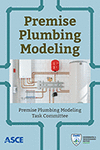2RA model68Abbreviations145–151Acanthamoeba70ACORN groups19Advection-dispersion (AD) equation58–60American National Standards Institute (ANSI)153American Society of Plumbing Engineers (ASPE)10Amoeba-resisting microorganisms (ARMs)73ARMs. See amoeba-resisting microorganismsASHRAE 90.196ASHRAE 188163–164ASPE. See American Society of Plumbing EngineersAWWA's M22 Manual of Water Supply Practice10, 14Backflow prevention valves47–48BIM. See building information modelsBiofilms56, 66, 72–76detachmentmathematical models for75and removal mechanisms76release models75–76and species growth models72–75Bottom-up approach of demand assignment (BUA)16Branch line, hot water systems90Brass55Building information models (BIM)137–139data management system for information on piping layouts139direct linkages to models139display mechanism138interoperability, platform for138Building water management programs162–163California building energy efficiency (case study)92–94CDF. See cumulative distribution functionsChick-Watson model77CHIPS and Science Act of 202229Chlorinated polyvinyl chloride (cPVC) pipes48, 50Chlorine66Civil and environmental engineers (CEE)29Clean water8; See also drinking waterClimate change/aging water infrastructure in Cincinnati (case study)141–142Collecting peak water-use readings10Community water systems64Computational fluid dynamics (CFD) modeling57, 107Computer-based analysis tools for WDS103–105Copper55–56, 63–64, 66Corrosion products2, 63–64COVID-19 Pandemic effect on peak water demand (case study)23–27during complete lockdown24–26on daily pattern of residential users24–26in district metered area24CPIS. See cumulative pressure-induced stressCross-linked polyethylene (PEX) pipes48, 50, 55, 64, 67–68CRTD. See cumulative residence time distributionCumulative distribution functions (CDF)25–26Cumulative pressure-induced stress (CPIS)45Cumulative residence time distribution (CRTD)61–62DAQs. See data acquisition systemsDarcy–Weisbach equation40Data acquisition systems (DAQs)100Dataloggers100Demand simulation30–31Digital twins139–140Disinfectant chemicals55–56Disinfectant residual64–68Disinfection76–79Disinfection by-product (DBP)66, 68–69Dispersion54–55AD equation58–60within circular pipe58–62in laminar flow58–62longitudinal dispersion coefficient60in transitional flow58–62in turbulent flow58–62Distribution of busy fixtures9District metered area (DMA)24, 27Drinking water1, 8demand16–17disinfection models77diurnal patterns of15–16Drinking water distribution systems (DWDS)16Dutch water system94DWDS. See drinking water distribution systemsEducation49Energy Policy Act (EPA)2, 9Environmental Protection Agency (EPA)140Environmental Water Resources Institute (EWRI)3EPA. See Energy Policy ActEPANET57, 68–69, 104, 109–110Erosion corrosion49Fixtures39, 47Fixture supply156Fixture-unit concept10Fixture Unit (FU) method153Fixture value10Flow and pressure modeling105–106Galvanized steel55Gaseous cavitation48–49Hazen-Williams equation40Hom and Haas models77Hot water heater54Hot water recirculation system91–92Hot water systems87–97branch line90California building energy efficiency (case study)92–94characteristics90codes and technology on Legionella risk and energy efficiency96–97layout of88Legionella outbreak in (case study)95–96main line90nonrecirculated87–88phases of89physical phenomena89real-world example of88–89recirculation system91–92simulation of energy consumption for hot water using stochastic model (case study)94–95temperature89trunk line90twig line90types of91–92viscosity of89–90Hunter, Roy9Hunter Number (H)11–12Hunter's curve9, 153–154Hydraulic control devices37–38, 46, 49–50parameters168in premise plumbing systems38–40, 105–108CFD models107demand modeling105flow and pressure modeling105–106implications161–162limitations of107–108transient models106–107water quality modeling106transientsin PPS40–42, 50in WDS42–46, 50IAPMO. See International Association of Plumbing and Mechanical OfficialsIndoor sprinklers8Indoor water use8–9; See also peak water demandInorganics63–64Installation48Instrumentation for PPM99–102, 167–171considerations for99–100data acquisition/collection100data management101location and placement of sensor100power requirements101sensor selection100energy parameters171hydraulic parameters168overview99–101sensor setup, example101–102water quality parameters169–171International Association of Plumbing and Mechanical Officials (IAPMO)10International Plumbing Code (IPC)153Intrusions, water supply system1Kinetic chlorine decay68–69Lead55–56, 63–64, 118–123dissolved118–120model results121–123particulate120–121Leaks8Legionella pneumophila55–56, 70, 72–74, 77–79, 95–97Legionnaires’ disease1, 56, 95–97Longitudinal dispersion coefficient60M. avium70Main line, hot water systems90Maintenance, preventive49Meters28Mixed-use buildings29–30Modified fixture-unit values10Monochloramine66Monte-Carlo-based stochastic model94Multifamily buildings, water use in27–28N. fowleri70National Institute of Standards and Technology (NIST)29, 140–141National Standard Plumbing Code (NSPC)153Natural gas94New age dawning29NIST. See National Institute of Standards and TechnologyNitrification66–67Nonrecirculated hot water systems87–88Nonresidential water demand16Opportunistic premise plumbing pathogens (OPPPs)1–3, 56, 69–72OPPPs. See opportunistic premise plumbing pathogensOutdoor water use8P. aeruginosa70Peak estimation29–30Peak water demand9–14alternatives to Hunter's curve10calculator11–14algorithms11–13software13–14COVID-19 Pandemic effect on (case study)23–27definition of9diurnal patterns15–16effect of weather on19–23Hunter's curve9metering and28modeling approaches16–17model resolution16in multifamily buildings27–28other factors affecting27–29Poisson rectangular pulse models18pricing and28pump technology and46–47residential water demands, multiple factors on27SIMDEUM model17–18task group initiative10–11Pipefeatures54–55materials46, 48, 55, 57, 66sizing methodsvs. hydraulic modeling161used in United States153–156sizing nomograph155–156velocity profiles58–59Plastic piping55, 64, 67–68Plumbing codes to design 45-unit apartment building (case study)157–160Plumbing materials55Plumbing systems8components8configurations8usage profiles8Point-of-entry (POE) devices2Poisson-binomial distribution12Poisson rectangular pulse (PRP) model18Polymers48Power supplies101PPM. See premise plumbing modelingPPS. See premise plumbing systemsPremise plumbing design vs. modeling160Premise plumbing information management136Premise plumbing modeling (PPM)3, 7–8applications and limitations of103–128hydraulic105–108water quality applications114–127water security applications108–114demand pattern16future of133–142building information models (BIM)137–139climate change/aging water infrastructure in Cincinnati (case study)141–142digital twins139–140premise plumbing information management136premise plumbing stakeholder engagement140–141smart water sensors134–136instrumentation for99–102Task Committee3temporal scale16webinar series on173–177Premise plumbing pathogens69–70Premise plumbing stakeholder engagement140–141Premise plumbing systems (PPS)1–3, 49–50boundary condition for38, 40demands39fixtures39hot water systems in87–97hydraulic models in38–40, 105–108CFD models107demand modeling105flow and pressure modeling105–106implications161–162limitations of107–108transient models106–107water quality modeling106hydraulics transients in40–42, 106–107transient I40–42transient II41–42transient III41–42modern, challenges with46–49backflow prevention valves47–48education49fixture47installation48materials48preventive maintenance49pump technology and peak water demand46–47temperature mixing valves47up-feed systems in high-rise buildings47workmanship48in residential buildings39risk and decision-making for (case study)123–125steady-state hydraulics within38water quality modeling in53–79, 114–127biofilms concern72–76concerns, examples of62–79disinfectant residual64–68disinfection by-product formation modeling68–69disinfection concern76–79inorganics concern63–64kinetic chlorine decay68–69mixing and longitudinal dispersion within circular pipe58–62OPPPs69–72vs. WDS, network feature104Pressure48–49, 105–106, 156–157Pricing, water28Primary pathogens69–70Public health and safety issues1–3Pump technology46–47Residence time distribution (RTD)61Residential indoor fixtures10Residential water demands27Residual disinfectants64–68Reynolds numbers54, 58–60Rovigo, Italy24RTD. See residence time distributionSecondary disinfectant64Sensors100SIMDEUM-DW18SIMDEUM-HW17–18SIMDEUM model15, 17–18, 94, 105applications18categories of Dutch residential water users in15for drinking water demand patterns17input into17temporal resolution in17–18SIMDEUM-WW17–18Simulation of energy consumption for hot water using stochastic model (case study)94–95Single species, microbial growth models for74Smart Water Network (SWN)43–44Smart water sensors134–136Social distancing policy24Stagnation1Street-level pressure38–39Surface Water Treatment Rule64SWN. See Smart Water NetworkTap8Task Committee of PPM3Task group initiative10–11Taylor's expression for turbulent flow Equation60Temperature49, 116–118Temperature mixing valves47Top-down approach of demand assignment (TDA)16–17Trihalomethane (THM)69Trunk line, hot water systems90Twig line, hot water systems90UC. See University of CincinnatiUniform Plumbing Code13–14, 153University of Cincinnati (UC)10Up-feed systems in high-rise buildings47Variable rate coefficient (VRC model)68Veterans Health Administration (VHA) hospital system96Water age53–54, 114–115Waterborne diseases1Water conservation1–2Water consumption8indoor8in multifamily buildings27–28outdoor8Water Demand Calculator (WDC)11–14, 105, 154algorithms11–13for commercial and institutional buildings29duration of peak demand30exhaustive enumeration (ExEn)12input/output template for13–14for mixed-use buildings29–30software13–14universal dimensionless curve for peak demands30web-based version of14and Wistort method12Water Distribution Systems Analysis (WDSA) Committee3Water distribution system (WDS)37–38in Adelaide (Australia)43–44computer-based analysis tools for103–105drinking, integrity of37hydraulic37–38, 42–46physical37quality37hydraulics transients in42–46vs. PPS, network feature104in United Kingdom43Water efficiency1–2Water fixture8Water management program development163–164Water meters28Water pricing28Water quality1, 106, 114–127behavior of premise plumbing system8in buildings53corrosion products and2monitoring164–165parameters169–171in PPS53–79biofilms concern72–76concerns, examples of62–79disinfectant residual64–68disinfection by-product formation modeling68–69disinfection concern76–79inorganics concern63–64kinetic chlorine decay68–69mixing and longitudinal dispersion within circular pipe58–62OPPPs69–72public health and safety issues and1–3water age and53–54Water quality applications114–127general constituent modeling115–116limitations of125–127risk and decision-making for (case study)123–125temperature116–118water age modeling114–115Water Quality Association (WQA)10Water Research Foundation (WRF)140Water security applications108–114in large venues111–114residential scale109–110Water supply networks50, 54WDC. See Water Demand CalculatorWDS. See water distribution systemWeather effect on peak water demand (study)19–23data19–20methodology20overview19results20–23Webinar series on PPM173–177Wistort, Robert12Wistort method12Workmanship48WQA. See Water Quality Association